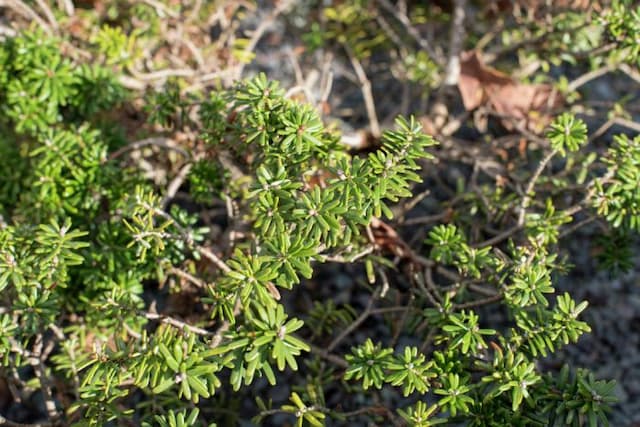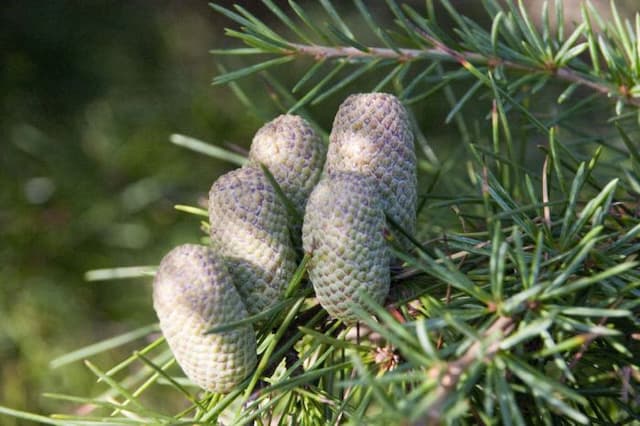Scots Pine Pinus sylvestris 'Watereri'

ABOUT
The Pinus sylvestris 'Watereri', commonly known as the Scots Pine 'Watereri', is a compact version of the popular evergreen tree. It has a uniquely dense, rounded to broadly pyramidal shape that distinguishes it from the usually tall and slender form of its parent species. The needles of this plant exhibit a vibrant blue-green hue, adding a splash of color to the landscape throughout the year. The foliage of the Scots Pine 'Watereri' is particularly noteworthy for its rich texture, comprised of short, sturdy needles that cluster together, producing a robust and bristly appearance. Each needle may span a couple of inches in length, and they grow in fascicles or small bundles, which is typical for many types of pines. This cultivar is prized for its decorative cones as well. The cones start out with a greenish tint, gradually maturing to a warm brown shade. They are often prominent against the foliage, providing visual interest even in the colder months. Overall, the Scots Pine 'Watereri' is recognized for its dense and stout form, with robust, bluish-green needles that maintain their color throughout all seasons, giving it a steadfast presence in any garden or landscape setting where it is planted.
About this plant
 Names
NamesFamily
Pinaceae
Synonyms
Watereri Scotch Pine, Watereri Scots Pine
Common names
Pinus sylvestris 'Watereri'.
 Characteristics
CharacteristicsLife cycle
Perennials
Foliage type
Evergreen
Color of leaves
Green
Height
4-6 feet (1.2-1.8 meters)
Spread
4-6 feet (1.2-1.8 meters)
Plant type
Tree
Hardiness zones
3-7
Native area
Europe
Benefits
 General Benefits
General Benefits- Ornamental Value: The compact, globular shape and distinctive blue-green foliage of the Scotch Pine 'Watereri' adds aesthetic appeal to gardens and landscapes.
- Drought Tolerance: Once established, it is highly tolerant of drought conditions, making it suitable for dry climates and water-conservative landscaping.
- Adaptability: It can grow in a wide range of soil types, from clay to sandy soils, as long as they are well-drained.
- Cold Hardy: This cultivar is resistant to cold and able to withstand harsh winter conditions, making it suitable for planting in colder regions.
- Low Maintenance: The slow-growing nature of 'Watereri' means it requires less pruning and upkeep compared to faster-growing species.
- Wildlife Support: Provides shelter and sometimes food for wildlife such as birds and squirrels.
- Soil Conservation: Its root system can help prevent soil erosion in certain landscapes.
- Windbreak: Can be used as a windbreak due to its dense foliage and robust form, especially when planted in groups.
 Medical Properties
Medical Properties- This plant is not used for medical purposes.
 Air-purifying Qualities
Air-purifying QualitiesThis plant is not specifically known for air purifying qualities.
 Other Uses
Other Uses- Woodworking: The timber of Scots pine 'Watereri' is suitable for small woodworking projects and crafts due to its appealing grain and workability.
- Rustic Furniture: Its sturdy branches and trunk can be used to create rustic furniture pieces such as stools and tables for garden settings.
- Christmas Decorations: The tree's small size and symmetrical shape allow it to be grown and used as a live Christmas tree in confined spaces.
- Bonsai: 'Watereri', like many pine species, can be trained as a bonsai specimen, offering an artistic hobby for enthusiasts.
- Pine Needle Crafts: The shorter needles can be collected and used to make pine needle baskets and other decorative items.
- Photography: This ornamental pine serves as an excellent subject for nature photographers due to its unique form and foliage.
- Nature Education: The tree can be used in educational settings to teach about coniferous plant growth and care practices in horticulture.
- Garden Sculpture: Trimmed and shaped 'Watereri' pine trees can act as natural sculptures within landscape design.
- Wind Barrier: When planted in rows or groups, Scots pine 'Watereri' can provide a windbreak for smaller gardens or outdoor areas.
- Wildlife Habitat: The dense canopy can offer shelter and nesting sites for birds and other small wildlife within a garden ecosystem.
Interesting Facts
 Feng Shui
Feng ShuiThe Scots Pine is not used in Feng Shui practice.
 Zodiac Sign Compitability
Zodiac Sign CompitabilityThe Scots Pine is not used in astrology practice.
 Plant Symbolism
Plant Symbolism- Longevity and Immortality: Pinus sylvestris, commonly known as Scots Pine, is a tree that lives for a long time. Its long lifecycle symbolizes endurance and the ability to withstand the test of time.
- Resilience: Scots Pine is known for its ability to grow in challenging conditions, which represents resilience and the capacity to overcome obstacles.
- Steadiness and Reliability: The sturdy nature of this pine tree is often seen as a symbol of steadiness and reliability, suggesting an unwavering presence.
- Purity: In some cultures, pine trees are associated with purity and cleansing because they were thought to repel evil spirits.
- Fertility: The prolific seed production of pines, including the Scots Pine, can symbolize fertility and creativity.
- Wisdom: The Scots Pine, due to its long lifespan, is sometimes associated with wisdom and the knowledge that comes with age.
 Water
WaterThe Scotch Pine 'Watereri' requires moderate watering, particularly during dry spells. It's important to water deeply and infrequently, allowing the soil to dry out between waterings to promote root health. During active growth in spring and summer, water with approximately 1 to 2 gallons every 1 to 2 weeks, adjusting for rainfall, as this pine does not require constant moisture. In fall and winter, reduce watering frequency. Avoid waterlogging the soil as it can lead to root rot.
 Light
LightScotch Pine 'Watereri' thrives in full sunlight conditions. It prefers a location where it can receive at least six hours of direct sun each day. Avoid heavily shaded areas, as insufficient light can impair growth and health. The plant's ideal spot is in an open landscape with clear exposure to the sun.
 Temperature
TemperatureThe ideal temperature range for Scotch Pine 'Watereri' is between 60°F and 70°F during its growing season. It can tolerate winter cold down to -20°F, making it quite hardy for colder climates. The tree should be protected from extreme heat, particularly in areas where temperatures can exceed 80°F for extended periods.
 Pruning
PruningPruning of Scotch Pine 'Watereri' is often unnecessary, as the tree naturally maintains a good shape. However, if needed, corrective pruning to remove broken or diseased branches can be done in late winter before new growth starts. Pruning, when done, should be minimal to maintain the tree's natural form.
 Cleaning
CleaningNot needed
 Soil
SoilScots Pine 'Watereri' requires well-draining soil with a pH range between 5.5 to 6.5. A soil mix with one-part peat, one-part pine bark, and one-part coarse sand or perlite is ideal. Ensure the soil allows for proper aeration and water drainage to prevent root rot.
 Repotting
RepottingScots Pine 'Watereri' typically needs repotting every 2-3 years. Younger trees may require more frequent repotting whereas mature specimens can be repotted less often, as their growth rate slows and they can handle being slightly root-bound.
 Humidity & Misting
Humidity & MistingScots Pine 'Watereri' is adaptable to a wide range of humidity levels but prefers average ambient humidity. As a conifer, it is well-suited to outdoor conditions and does not require specific humidity control as long as it is not planted in excessively dry environments.
 Suitable locations
Suitable locationsIndoor
Grow Scots Pine 'Watereri' in a bright spot with good air circulation.
Outdoor
Plant Scots Pine 'Watereri' in full sun and well-draining soil.
Hardiness zone
3-7 USDA
 Life cycle
Life cycleThe Scots pine 'Watereri' begins its life as a seed, which after conditions are favourable, germinates and establishes itself as a seedling with a primary root and cotyledons (seed leaves). As it matures into a sapling, it develops a woody stem and true leaves, resembling miniature adult foliage, and the root system expands. During the juvenile phase, it experiences rapid vertical growth, and its crown starts to take the distinctive, often irregular, conical shape. Reaching maturity, the 'Watereri' begins reproductive cycling, producing both male cones which release pollen and female cones which, after pollination, develop into seed-bearing structures. Over years to decades, the mature tree may experience cycles of cone production, growth, and dormancy, with a lifespan that can extend over a century. In its final stage as a senescent tree, it will slow in growth and eventually die, leaving seeds that can perpetuate the species.
 Propogation
PropogationPropogation time
Late winter-early spring
The Scots Pine 'Watereri' is typically propagated by seed, which tends to be the most popular method for this species. Timing for sowing seeds of the Scots Pine 'Watereri' is best in the late winter to early spring. To propagate by seed, collect the cones in late fall before they have opened. Store them in a warm, dry place until they open and release their seeds. The seeds require stratification, a process of cold treatment, for about 60 days at temperatures around 33-41°F (0.5-5°C) to break dormancy. After stratification, the seeds are sown in well-draining soil and covered lightly with sand or a sand-soil mix. They should be kept moist and in a location with bright, indirect light until germination, which usually takes a few weeks to a couple of months.









